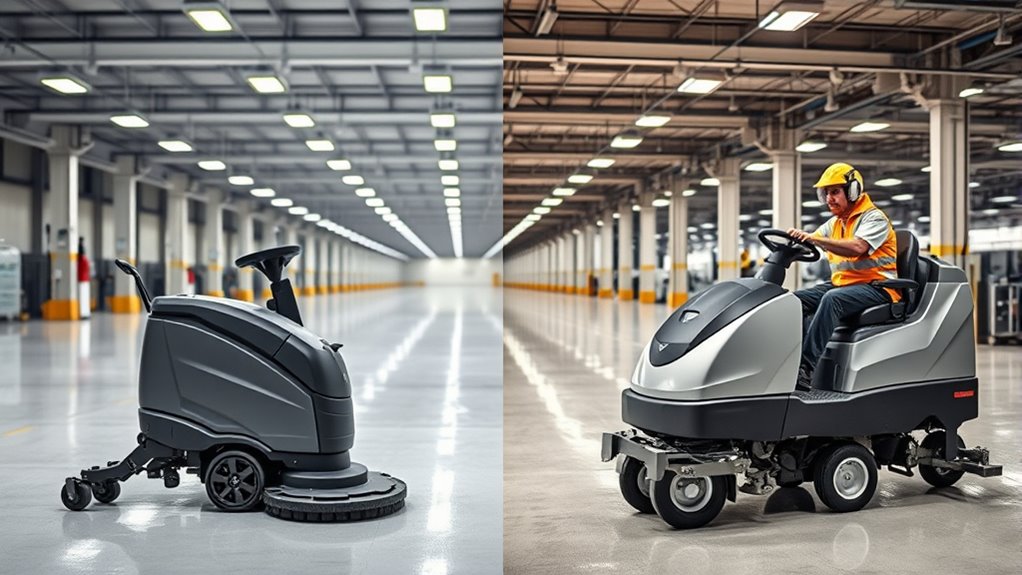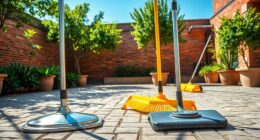Choosing between walk-behind and ride-on scrubbers impacts your efficiency more than you might think. Walk-behind models are simple, easier to operate, and cost less upfront, but they need more frequent recharges and may slow down large jobs. Ride-on scrubbers offer longer battery life, higher productivity, and are perfect for big spaces, although they require more training and investment. If you want to discover how to maximize your cleaning operations, keep exploring these options.
Key Takeaways
- Ride-on scrubbers offer longer battery life, enabling extended cleaning sessions and higher productivity for large-scale facilities.
- Walk-behind models are simpler to operate and maintain, with minimal training required, ideal for smaller or less complex spaces.
- Although ride-on units have higher initial costs, their efficiency reduces labor hours and operational expenses over time.
- Smaller batteries in walk-behind scrubbers necessitate frequent recharging or multiple units, impacting operational continuity.
- The choice depends on facility size; larger spaces benefit from ride-on models, while smaller areas suit walk-behind scrubbers.

When choosing between walk-behind and ride-on scrubbers, understanding their differences can help you make the right decision for your cleaning needs. One key factor to consider is battery life. Walk-behind models typically have smaller batteries, which means they might need more frequent recharging during extended cleaning sessions. If you’re managing large areas or multiple shifts, a ride-on scrubber with a larger battery capacity can keep working longer without interruptions. This extended battery life boosts productivity and reduces downtime, making ride-on options appealing for large-scale operations. Conversely, walk-behind scrubbers often recharge quickly and are easier to swap out batteries on, which can be advantageous if you have a well-organized maintenance routine. Considering the design complexity of different models can also influence ease of maintenance and repair, impacting overall operational efficiency.
Operator training is another essential aspect that influences your choice. Walk-behind machines are generally simpler, with straightforward controls and minimal operational complexity. This makes them easier to train staff on and reduces the learning curve, especially if your team has varying experience levels. On the other hand, ride-on scrubbers, while more feature-rich, require more extensive training. Operators need to learn how to maneuver larger equipment safely, handle controls effectively, and troubleshoot issues on the fly. Proper training is vital to maximize efficiency and guarantee safety, especially since ride-on models often have more advanced features like adjustable scrub pressure, differing cleaning modes, and larger water tanks.
Operator training varies: walk-behind models are simpler, while ride-on scrubbers require extensive instruction for safe, effective use.
Cost considerations also come into play when weighing these factors. Walk-behind scrubbers tend to be less expensive upfront, making them appealing for smaller facilities or budgets tight on initial investment. However, their limited battery capacity and longer operation times might mean more frequent charging or additional units needed for continuous cleaning. Ride-on scrubbers, although more costly initially, often offer lower operational costs over time due to their longer battery life and higher productivity. They’re designed for continuous, large-area cleaning, which can offset their higher purchase price through increased efficiency.
Ultimately, your choice hinges on the specific needs of your environment. If you operate a small to medium-sized facility with manageable cleaning schedules, a walk-behind might suffice, especially if ease of use and quick training are priorities. For larger, high-traffic spaces requiring continuous cleaning, investing in a ride-on scrubber could deliver better long-term value. Remember, evaluating the battery life and operator training requirements upfront guarantees you’ll select a machine that fits seamlessly into your operation, maximizes efficiency, and minimizes downtime.
Frequently Asked Questions
Which Type of Scrubber Is More Cost-Effective Long-Term?
When considering long-term cost-effectiveness, you should focus on a thorough cost analysis and lifespan comparison. Ride-on scrubbers often have higher upfront costs but may offer better efficiency and durability, reducing maintenance expenses over time. Walk-behind models are cheaper initially but might require more frequent repairs and take longer to complete tasks. Ultimately, choosing based on operational needs and total cost of ownership guarantees you make the most economical decision.
How Do Maintenance Needs Differ Between Walk-Behind and Ride-On Models?
You’ll find ride-on scrubbers generally have longer battery life and require less frequent repairs compared to walk-behinds. Maintenance needs differ mainly in repair complexity; ride-ons tend to have more complex components, making repairs potentially more costly and time-consuming. However, their durability often means less downtime. With proper upkeep, both models can serve well, but understanding these differences helps you plan for long-term maintenance costs effectively.
Can Both Scrubber Types Handle Outdoor Cleaning Tasks?
Both walk-behind and ride-on scrubbers can handle outdoor cleaning tasks, but their outdoor capabilities vary. Walk-behind models are typically more maneuverable for tight spaces, while ride-on scrubbers cover larger areas efficiently. Consider power source options like battery or propane, which influence outdoor usability. Battery-powered models offer quiet, emission-free operation, ideal for sensitive environments, whereas propane models provide longer runtime and more power for tough outdoor surfaces.
Which Scrubber Type Offers Better Maneuverability in Tight Spaces?
In tight spaces, maneuverability is key. Walk-behind scrubbers excel in narrow passages and space constraints because of their compact size and agility. You can easily navigate around obstacles and clean small areas without hassle. Ride-on scrubbers, while powerful, may struggle in extremely narrow passages due to their larger footprint. So, if your focus is on tight spaces, a walk-behind scrubber offers better maneuverability and efficiency.
How Does Operator Training Vary Between Walk-Behind and Ride-On Machines?
Like a knight preparing for battle, your operator training varies between walk-behind and ride-on scrubbers. With walk-behind models, you need more hands-on training to guarantee operator safety and handling precision, making the process more complex. Ride-on machines, however, often feature intuitive controls, simplifying training. You’ll find that understanding the machine’s features and safety protocols is vital, but ride-ons typically require less time to master, boosting efficiency.
Conclusion
Choosing between walk-behind and ride-on scrubbers is like selecting the right vehicle for a journey—you’ll go faster and farther with the right fit. Imagine a small business that switched to a ride-on scrubber, boosting productivity by 30% and cutting cleaning time in half. Just as a skilled driver knows when to shift gears, understanding your cleaning needs helps you optimize efficiency. Ultimately, the right scrubber accelerates your success and keeps your business moving smoothly.









